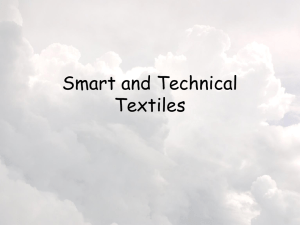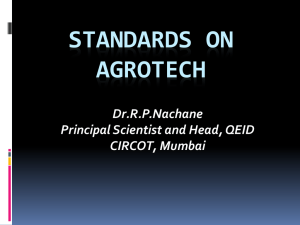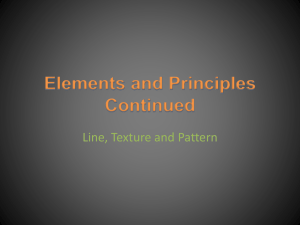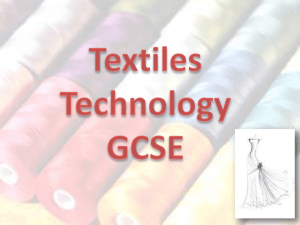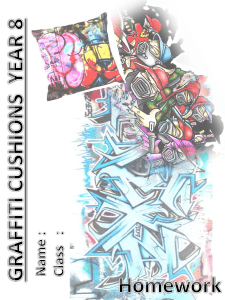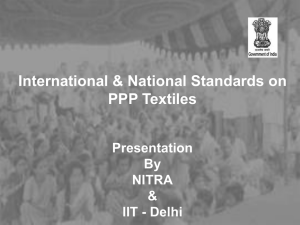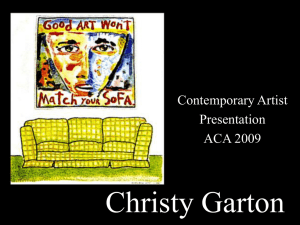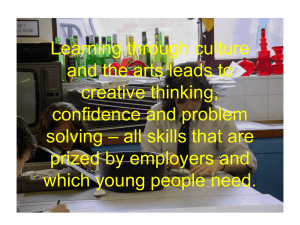File - Ricards Lodge Art Department
advertisement
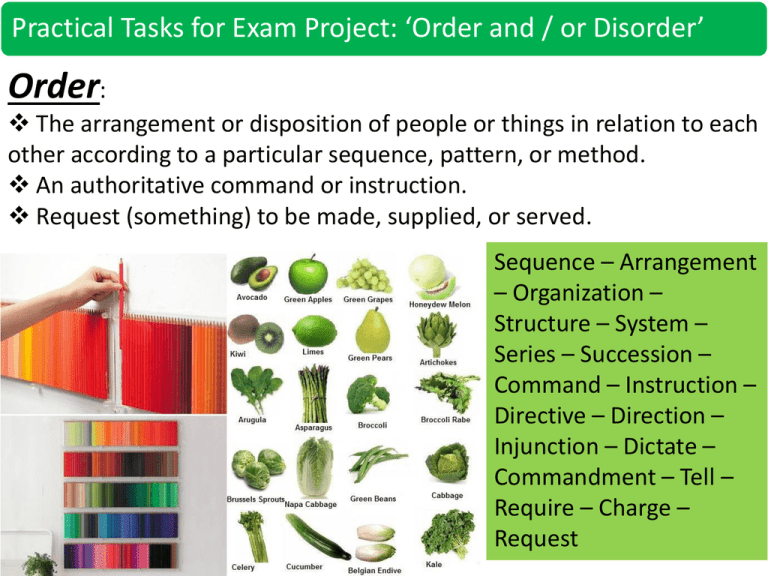
Practical Tasks for Exam Project: ‘Order and / or Disorder’ Order: The arrangement or disposition of people or things in relation to each other according to a particular sequence, pattern, or method. An authoritative command or instruction. Request (something) to be made, supplied, or served. Sequence – Arrangement – Organization – Structure – System – Series – Succession – Command – Instruction – Directive – Direction – Injunction – Dictate – Commandment – Tell – Require – Charge – Request Practical Tasks for Exam Project: ‘Order and / or Disorder’ Disorder: A state of confusion. The breakdown of peaceful and law-abiding public behaviour. An illness that disrupts normal physical or mental functions. Unrest – Disturbance – Disruption – Upheaval Mayhem – Untidy Messy – Disarranged – Tangled – Knotted – Matted – Straggly Windswept – Windblown – Wild – Infection – Complaint – Sickness – Illness – Infirmity Practical Tasks for Exam Project: ‘Order and / or Disorder’ Order and / or Disorder: What do I need to do to successfully prepare for my exam?... Firstly: you need to do research. Research into artists, case studies, books, anything that inspires you or makes you think it links with the theme. You can discuss potential ideas with classmates but you must individually show a process of ideas in your sketchbook which leads to your final concept. Include lots of samples, samples, SAMPLES!!! If you do your own research independently you are more likely to come up with a final idea which motivates you to complete it. Make it personal to you, something you are interested in - that is what art is about. The theme is very open and can be related to many possibilities, so have fun with it! Practical Tasks for Exam Project – Art Textiles Artist: Yee Soo Kyung http://www.saatchigallery.com/artists/yeesookyung.htm?section_name=body_l anguage Firstly: Draw a piece of ceramic as accurately as you can onto fabric, focus on shape and colour. Machine stitch over your drawing. Then: Smash it! Then glue it back together in an unusual way. Next: Redraw the object onto another piece of fabric, focus on shape and colour. Embellish using a sewing machine. Use wadding to create a textural surface. Extension 1: Draw from different angles. Extension 2: Blind contour drawings in different coloured pencils. Use coloured thread to interpret your drawing. Practical Tasks for Exam Project – Art Textiles Artist: Marco Ugolini http://www.jesuismonreve.org/per-color/ •Organise your shopping into baskets of different coloured items. Photograph •Organise your shopping on the conveyor belt into the colours of the rainbow. Red, Yellow, Green, Blue, Indigo, Violet. Photograph •Organise the contents of you fridge / cupboards into colour order. Photograph •Choose a selection of objects that are the same colour. From this still life create an appliqué. Use coloured fabrics or paint fabrics to get the exact colours that you can see. Practical Tasks for Exam Project – Art Textiles Artist: Sakir Gökçebag http://www.sakirgokcebag.com/HomePage.aspx Using food or other similar objects of your choice, reorganise them to create shapes and patterns. Photograph the outcomes. You could: Cut an object into sections and create a pattern using the pieces. Photograph and create an appliqué or embroidered piece to represent your photograph. Or instead: Cut the object into sections and create repeated prints from the object to create interesting shapes on fabric. Practical Tasks for Exam Project – Art Textiles Artist: Sakir Gökçebag http://www.sakirgokcebag.com/HomePage.aspx This is created using toilet rolls... Could you create something similar using rolled up fabrics?... Practical Tasks for Exam Project – Art Textiles Artist: Emilie Faif http://emiliefaif.com/1sculpture.html Draw the silhouetted shapes of either a series of related objects, or unrelated objects. Connect the silhouettes together to create one fabric shape. Cut two identical versions of the main shape. Sew them together and pad them using stuffing to create an irregular cushion. Consider how your choice of objects could represent Order (combination of appropriate objects) or Disorder (combination of objects which would never normally be viewed together). Practical Tasks for Exam Project – Art Textiles Artist: Thomas Grunfeld http://www.ravishingbeasts.com/gallery/fraudulentanimals/1319517 Cut up images of animals and collage / appliqué them back together to create unusual ‘misfits’. (You could print them onto fabric using Transfer / Freezer Paper) Use good quality images and this would be great if you could take your own photographs. Embellish the new animals using a range of embroidery stitches / machine stitching / appliqué / quilting / components, etc. Practical Tasks for Exam Project – Art Textiles Artist: Brooks Shane Salzwedel http://www.brookssalzwedel.com/portfolio.html Make primary drawings on tracing paper using a pencil or permanent pen. Layer the different sheets of paper to give the effect of distance within your image. Stitch into the layers to create additional effects. Practical Tasks for Exam Project – Art Textiles Artist: Lauren DiCioccio http://laurendicioccio.com/objects/-365-days-of-print-onlineresidency-february-2011 You could: Either stitch into an existing newspaper or print a section onto fabric using Transfer / Freezer Paper. Alternatively: Create your own newspaper title and headline directly onto calico. Then: Cut or rip the section to look more organically frayed at the edges. Stitch into the headlines and words, allowing the threads to remain long and tangled at the ends. Practical Tasks for Exam Project – Art Textiles Artist: Ines Seidel http://ines-seidel.de/?lang=en Or: http://www.pinterest.com/Innerlijk/ines-seidel/ Create 3D paper mache ‘shells’ or ‘bowls’ using old newspapers, book pages or musical sheet music. Design into them using Indian Ink like Ines Seidel uses, or stitch designs directly into them / onto them using embroidery threads. Practical Tasks for Exam Project – Art Textiles Artist: Clare Knox Bentham http://www.clareknoxbentham.co.uk/ Create either blind contour drawings or continuous line drawings of objects you feel have an order or connection to each other: theme, colour, size, shape, material... (for example round objects, green objects, shoes, bottles, etc.) Either: Use string, wire, wool or embroidery thread to reproduce your drawings either onto fabric or onto dissolvable fabric to create a hollow installation. Photograph or present directly into your sketchbook. Alternatively: Take inspiration from Clare Knox Bentham and use a melted plastic process by placing twisted pieces of plastic bag between layers of cling film and ironing them together. This will bond and fuse the plastic – make sure you put layers of newspaper between the iron and the cling film first! Practical Tasks for Exam Project – Art Textiles Artist: Clare Knox Bentham http://www.clareknoxbentham.co.uk/ Create either blind contour drawings or continuous line drawings of objects you feel have an order or connection to each other: theme, colour, size, shape, material... (for example round objects, green objects, shoes, bottles, etc.) Either: Use string, wire, wool or embroidery thread to reproduce your drawings either onto fabric or onto dissolvable fabric to create a hollow installation. Photograph or present directly into your sketchbook. Alternatively: Take inspiration from Clare Knox Bentham and use a melted plastic process by placing twisted pieces of plastic bag between layers of cling film and ironing them together. This will bond and fuse the plastic – make sure you put layers of newspaper between the iron and the cling film first! Practical Tasks for Exam Project – Art Textiles Artist: Liz Cooksey http://lizcooksey.com/page4.htm You could: Draw shapes of objects based on primary observation and gather interesting surfaces, fabrics, ribbons and wire to create a mixed media Textiles piece. Then: Compose and order your images within a shape like a circle, triangle or hexagon. Use appliqué, reverse appliqué, hand embroidery and surface embellishments to combine your images, fabrics and components together. Practical Tasks for Exam Project – Art Textiles http://ricardslodgeart.weebly.com/exam-project-20141.html http://www.studentartguide.com/articles/a-level-art-ideas# http://www.art2day.co.uk/order-and-disorder.html http://www.pinterest.com/dragontreasure/ Learning Objective Understand the format of our art exam and how to generate ideas for potential artwork. Literacy Objective Understand, use and apply these key words: Mind map WAGOLL Thorough with lots of branches Each branch is well developed with more than one idea Images used to illustrate ideas This is what a good one looks like Religious Political Colour Shape Order and / or Disorder Nature Pattern ? Urban Size Society & Culture GCSE ART Assessment A Very thorough and highly detailed mind map containing a broad range of possible starting points B Thorough and detailed mind map containing a range of possible starting points C Effective mind map containing a range of possible starting points


